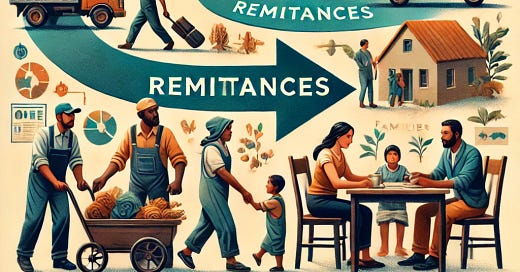The Economics of Remittances: A Lifeline for Developing Economies
Every year, millions of migrants around the world send money back home to support their families. These transfers, known as remittances, may seem like small, personal transactions, but collectively, they are a financial powerhouse. In 2023, remittances to low- and middle-income countries reached an estimated $540 billion, outpacing foreign direct investment (FDI) and official development assistance (ODA) combined.
Let’s dive into the economics of remittances—why they matter, how they shape global economies, and the challenges and opportunities they bring.
What Are Remittances?
Remittances are money transfers made by migrants to individuals in their home country. These transfers are often sent through formal channels (like banks or money transfer services) or informal networks (like family members or friends).
They’re typically used for:
Basic Needs: Food, housing, education, and healthcare.
Small Investments: Starting a business or purchasing land.
Savings: Providing a safety net for the future.
Why Are Remittances So Important?
Poverty Reduction
Remittances provide direct financial support to households, helping lift millions of families out of poverty. They often account for a significant portion of household income in recipient countries, enabling access to essential goods and services.Economic Stability
For many countries, remittances serve as a stable source of foreign currency, particularly during economic crises. Unlike volatile foreign investments, remittance flows are relatively consistent, even in times of global economic downturns.Education and Health Improvements
Studies have shown that families receiving remittances are more likely to invest in education and healthcare. For example, children in remittance-receiving households are often better nourished and attend school more consistently.Boosting Local Economies
When remittance recipients spend money, it stimulates local businesses and contributes to economic growth. These inflows can increase demand for goods and services, creating a ripple effect throughout the economy.
The Global Leaders in Remittances
Some countries are both the biggest sources and recipients of remittances, reflecting global migration patterns and economic ties.
Top Remittance-Sending Countries:
United States – With a large immigrant population, the U.S. is the leading source of remittances globally.
United Arab Emirates – A major destination for migrant workers from South Asia and Africa.
Saudi Arabia – Similar to the UAE, it employs a vast number of foreign workers.
Top Remittance-Receiving Countries:
India: Over $100 billion in remittances annually, primarily from the Middle East, the U.S., and the U.K.
Mexico: A lifeline for millions of households, with a large portion coming from Mexican migrants in the U.S.
Philippines: Workers in the Middle East, the U.S., and Europe contribute billions to the economy each year.
Challenges in the Remittance Ecosystem
High Transaction Costs
Sending money across borders is expensive. On average, fees for remittances are around 6% of the total transaction, but they can be significantly higher for certain regions. The United Nations’ Sustainable Development Goals aim to reduce these costs to 3% or lower by 2030.Access to Formal Channels
Many migrants lack access to formal banking systems, forcing them to rely on informal and less secure methods. Expanding financial inclusion is critical to making remittances safer and more efficient.Currency Fluctuations
Exchange rate volatility can reduce the value of remittances in the recipient’s local currency. For example, a strengthening U.S. dollar might mean fewer pesos, rupees, or naira for families back home.Dependence on Remittances
While remittances provide short-term relief, heavy reliance on them can discourage long-term economic development. Countries that depend heavily on remittances may neglect other avenues for growth, like industrialization or infrastructure investment.
The Future of Remittances: Trends and Innovations
Digital Platforms and FinTech
Companies like TransferWise (now Wise), Remitly, and PayPal are transforming the remittance landscape by offering faster, cheaper, and more transparent ways to send money. Mobile payment systems like Kenya’s M-Pesa have revolutionized money transfers in Africa, making it easier for rural populations to access remittances.Cryptocurrencies
Blockchain technology has the potential to disrupt traditional remittance systems by enabling direct, peer-to-peer money transfers with lower fees. For example, Bitcoin is already being used by some migrants to bypass high bank fees, though regulatory challenges remain.Government Policies
Governments in remittance-receiving countries are recognizing the importance of these inflows and implementing policies to maximize their impact. For instance, tax incentives for migrant savings or matching funds for remittance-backed development projects can encourage investment in local economies.Climate and Conflict
Climate change and geopolitical conflicts are expected to drive more migration, potentially increasing global remittance flows. However, these movements also pose challenges for the sustainability of remittance-dependent economies.
What Does It All Mean for Global Economics?
Remittances are a vital thread in the fabric of global economics. They represent the human side of globalization—real people supporting their families and communities across borders. However, for these funds to have a lasting impact, recipient countries need to channel remittance flows into sustainable development initiatives. At the same time, sending countries must continue to innovate and reduce barriers to transferring money.
As the world becomes more interconnected, the role of remittances will only grow. By addressing the challenges of high fees, financial access, and economic dependency, we can unlock the full potential of these financial lifelines.





